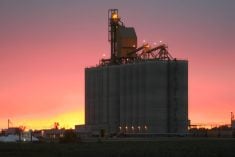Being high tech does not necessarily mean being online. It often means finding a way to use technology in a manner that works for your business. This is the case for the Donalda Hutterite colony’s participation in the technologically based Alberta Lamb Traceability Pilot Project (LTPP).
“We signed up right away, and it has made a big difference in our record keeping,” says
Andrew Hofer, shepherd at the Donalda Colony in Eastern Alberta says. “We don’t use the Internet, but we do use basic computers. With a few changes we were able to make the program work, and work well for us.”
Read Also

Cancer agency reclassifies another herbicide ‘probably carcinogenic’
The WHO’s cancer research agency has now put atrazine, a herbicide well known to corn growers, in the same potential-hazard category where the agency put glyphosate.
The colony is home and workplace for 111 people. Sheep have long been a traditional part of colony life. The Donalda colony added sheep to their operation in 1977 and the flock has slowly grown over the years to their current size, with 250 mature ewes and 90 lamb ewes.
There are 60 Hutterite colonies in Alberta that keep sheep flocks. These colonies produce about 20 per cent of Alberta’s market lambs. Margaret Cook, executive director of Alberta Lamb Producers says that many colonies have expanded in recent years and are some of the larger operators. Colony managers tend to look for business opportunity, they are able to take advantage of economies of scale, they are investing in new technology in many of their enterprises and they have access to sufficient labour. For these reasons it was important that colonies participate in the traceability project.
“The LTPP is a pilot project, so we wanted to ensure that it would work for all types of operations, including colonies,” says Cook. “We have a training component to make sure they have a strong understanding of the new technology and how it can help them with management of their sheep enterprise. We also know that members of the Hutterian brethren have an excellent communications network so by having a few colonies as cooperators, the information will then be shared with their contacts.”
The project has a large online component, so working without the Internet required working within existing systems to make sure that everyone’s needs were met. Special arrangements are being investigated to see if cooperator colonies could access internet-based information on their lambs and carcasses. Access to that information will help decision makers within the colony see some of the benefits from the program. The project website ( www.sheepcentral.ca) has both open and member areas that provide technical information on electronic technology systems.
“For me, record keeping has not been strong up until now,” says Hofer. “I would check the records maybe once or twice a year and it’s hard to be on top of production information that way. Now I can find everything I need to know instantly. I check the information on our flock all the time, usually daily.”
Cook says good records are a large part of good management decisions, including the identification of the most and least profitable ewes. Accurate data, time savings and easily-accessed reports have been identified by producers as some of the benefits of electronic management systems in which RFID tags (radio frequency ear tags) are used to track data.
The LTPP, a collaborative effort managed by Alberta Agriculture with funding under Alberta Livestock &Meat Agency, is finishing up its third year. The project has enlisted 43 producerco- operators as well as processors, buyers and feedlots involved. One of the key objectives of the project has been to test the equipment and systems on a variety of farms. The project team is now able to make recommendations on technology to suit different needs. Co-operator feedback is used to continually refine the project, the technology being used, training needs and the cost and benefits of moving to a new management system.
Hofer says he sees opportunities for further improvements to the system, and he’s glad to have the opportunity to contribute. “I would like to see more information on the feed end of things,” he says. “Overall the tags and management software have made me more aware of what’s going on with each ewe, but adding in more feed information would cover everything I need to know.”
Currently, co-operators are submitting their production cost data to develop industry benchmarks and models for different types of operations. The focus is on using electronic management information to create increased profitability for producers. More details will be available in the next few months on the Alberta Lamb Producers website ( www.ablamb.ca), in their newsletter and on sheepcentral.ca.
“I think the lamb we produce in Alberta is some of the best out there,” says Hofer. “But we need twice as much. I think some increased production will come from cattle and hog ranchers who are looking to change things up a bit. But it’s not as easy to change a cowboy into a shepherd as some might think, so having good information will help bring bigger and better flocks.”
ArticlecourtesyAlbertaLambProducers














